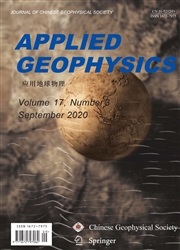Q full-waveform inversion based on the viscoacoustic equation
作者:Wang En-Jiang,Liu Yang,Ji Yu-Xin,Chen Tian-Sheng,Liu Tao
摘要:Presently, most full-waveform inversion methods are developed for elastic media and ignore the effect of attenuation. The calculation of the quality factor Q is based on velocity parameter inversion under the assumption of a given Q-model that is obtained by tomographic inversion. However, the resolution of the latter is low and cannot reflect the amplitude attenuation and phase distortion during wave propagation in viscoelastic media. Thus, a Q waveform inversion method is proposed. First, we use standard linear body theory to describe attenuation and then we derive the simplified viscoacoustic equation that characterizes amplitude attenuation and phase distortion. In comparison with conventional equations, the simplifi ed equation involves no memory variables and therefore requires less memory during computation. Moreover, the implementations of the attenuation compensation are easier. The adjoint equation and the corresponding gradient equation with respect to either L2-norm or the zero-lag cross-correlation objective function are then derived and the regularization strategy for overcoming the instability during numerical solution of the adjoint equation is proposed. The Q waveform inversion is developed using the limited-memory Broyden–Fletcher– Goldfarb–Shanno (L-BFGS) iteration method for known velocity. To alleviate the dependence of the waveform inversion on the initial model and overcome cycle skipping to some extent, we adopt multiscale analysis. Furthermore, anti-noise property and double-parameter inversion are assessed based on the results of numerical modeling.
发文机构:State Key Laboratory of Shale Oil and Gas Enrichment Mechanisms and Effective Development School of Earth Science and Engineering College of Geophysics and Information Engineering Sinopec Petroleum Exploration and Production Research Institute Sinopec Key Laboratory of Multiwave Seismic Technology
关键词:QualityFACTORQfull-waveformINVERSIONATTENUATIONSTABILITY
分类号: O[理学]
- 基于LSTM-RNN的地震前兆数据异常检测新方法
- An improved Gaussian frequency domain sparse inversion method based on compressed sensing
- Resistivity dispersion in pyrite-bearing shaly sandstones
- 深度域叠前弹性波阻抗反演
- Early monitoring of gas infl ux of drilling fl uid in risers during deepwater drilling using Lamb waves
- 喀斯特地区煤田多孔联采3D-RVSP勘探实践:以中国五轮山为例
- 基于4D地震技术的煤矿采空区监测
- 四川龙马溪组正交各向异性页岩储层地震AVAZ反演
- Low-frequency swell noise suppression based on U-Net
- 基于协方差矩阵的地磁场急变特征提取研究


